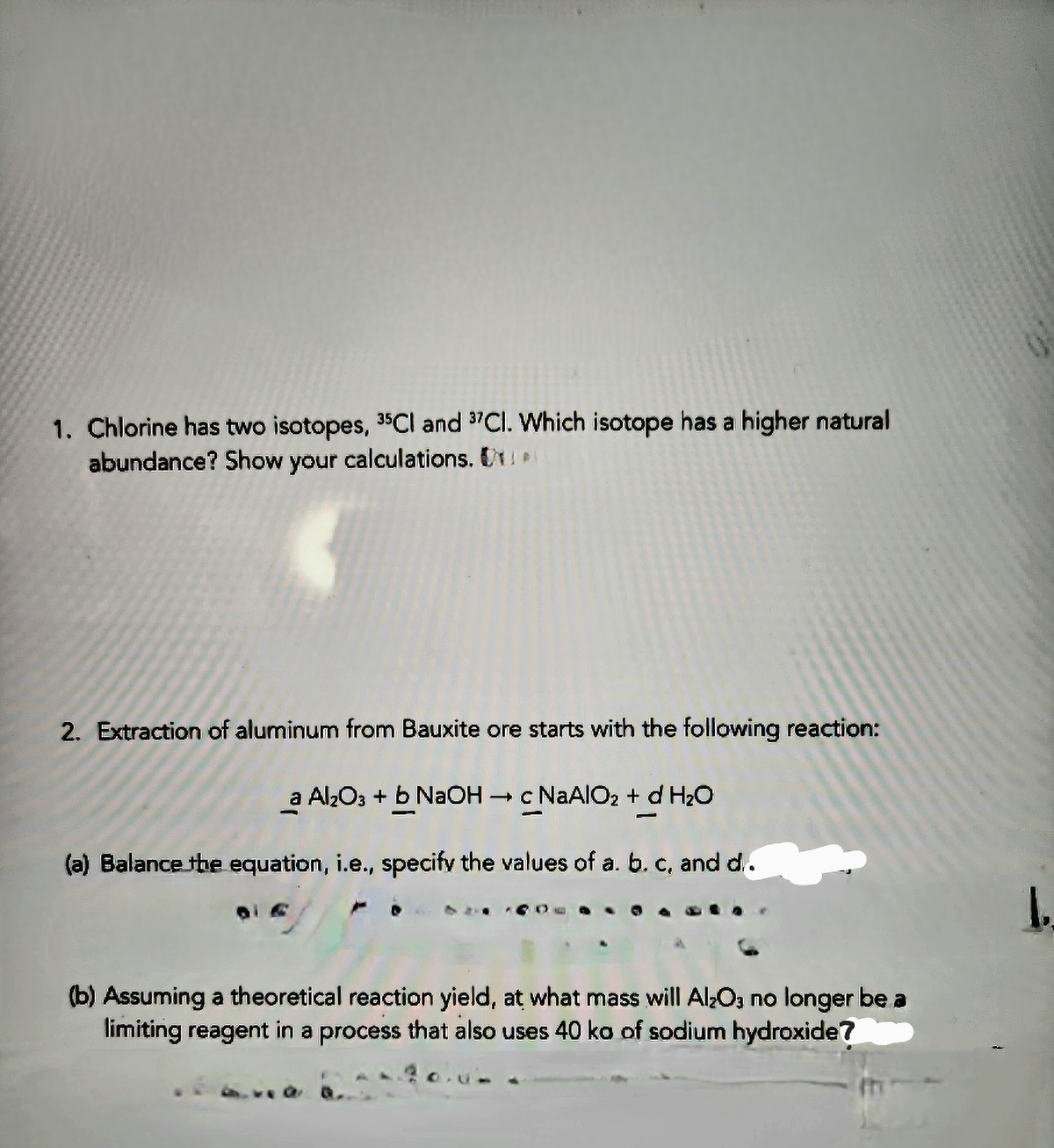1. Chlorine has two isotopes, 35Cl and 37Cl. Which isotope has a higher natural abundance? Show your calculations. U 2. Extraction of aluminum from Bauxite ore starts with the following reaction: a Al₂O3 + b NaOH → c NaAlO₂ + d H₂O (a) Balance the equation, i.e., specify the values of a. b. c, and d. (b) Assuming a theoretical reaction yield, at what mass will Al₂O3 no longer be a limiting reagent in a process that also uses 40 ko of sodium hydroxide?
1. Chlorine has two isotopes, 35Cl and 37Cl. Which isotope has a higher natural abundance? Show your calculations. U 2. Extraction of aluminum from Bauxite ore starts with the following reaction: a Al₂O3 + b NaOH → c NaAlO₂ + d H₂O (a) Balance the equation, i.e., specify the values of a. b. c, and d. (b) Assuming a theoretical reaction yield, at what mass will Al₂O3 no longer be a limiting reagent in a process that also uses 40 ko of sodium hydroxide?
Chemistry: Principles and Reactions
8th Edition
ISBN:9781305079373
Author:William L. Masterton, Cecile N. Hurley
Publisher:William L. Masterton, Cecile N. Hurley
Chapter8: Thermochemistry
Section: Chapter Questions
Problem 23QAP: In the late eighteenth century Priestley prepared ammonia by reacting HNO3(g) with hydrogen gas. The...
Related questions
Question
Please answer question 2

Transcribed Image Text:1. Chlorine has two isotopes, 35Cl and 37Cl. Which isotope has a higher natural
abundance? Show your calculations. U
2. Extraction of aluminum from Bauxite ore starts with the following reaction:
a Al₂O3 + b NaOH → c NaAlO₂ + d H₂O
(a) Balance the equation, i.e., specify the values of a. b. c, and d.
(b) Assuming a theoretical reaction yield, at what mass will Al₂O3 no longer be a
limiting reagent in a process that also uses 40 ko of sodium hydroxide?
Expert Solution
Step 1
Answering only question number 2 as asked
Two questions to be answered
question 1
balance a chemical equation
question 2
find the mass of limiting reagent.
Step by step
Solved in 6 steps with 11 images

Knowledge Booster
Learn more about
Need a deep-dive on the concept behind this application? Look no further. Learn more about this topic, chemistry and related others by exploring similar questions and additional content below.Recommended textbooks for you

Chemistry: Principles and Reactions
Chemistry
ISBN:
9781305079373
Author:
William L. Masterton, Cecile N. Hurley
Publisher:
Cengage Learning

Chemistry & Chemical Reactivity
Chemistry
ISBN:
9781337399074
Author:
John C. Kotz, Paul M. Treichel, John Townsend, David Treichel
Publisher:
Cengage Learning

Introductory Chemistry: A Foundation
Chemistry
ISBN:
9781285199030
Author:
Steven S. Zumdahl, Donald J. DeCoste
Publisher:
Cengage Learning

Chemistry: Principles and Reactions
Chemistry
ISBN:
9781305079373
Author:
William L. Masterton, Cecile N. Hurley
Publisher:
Cengage Learning

Chemistry & Chemical Reactivity
Chemistry
ISBN:
9781337399074
Author:
John C. Kotz, Paul M. Treichel, John Townsend, David Treichel
Publisher:
Cengage Learning

Introductory Chemistry: A Foundation
Chemistry
ISBN:
9781285199030
Author:
Steven S. Zumdahl, Donald J. DeCoste
Publisher:
Cengage Learning


Chemistry
Chemistry
ISBN:
9781305957404
Author:
Steven S. Zumdahl, Susan A. Zumdahl, Donald J. DeCoste
Publisher:
Cengage Learning